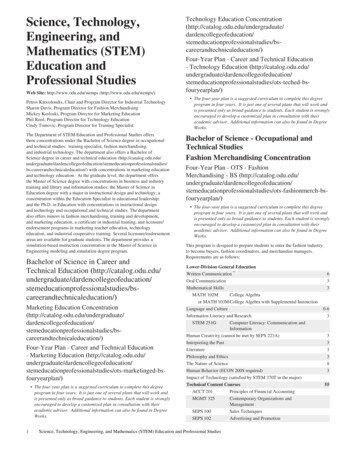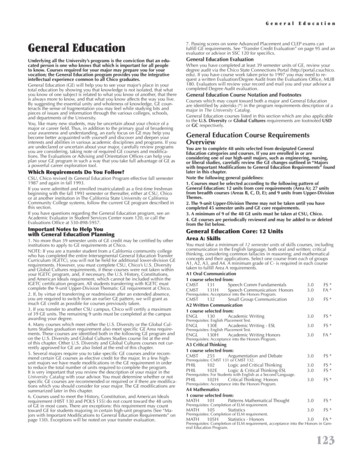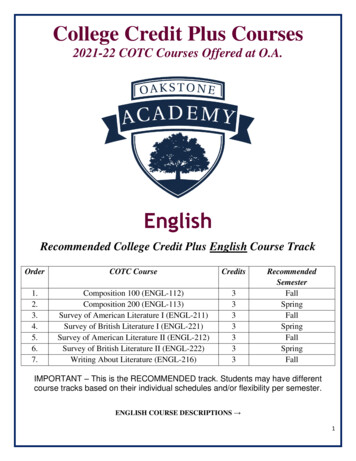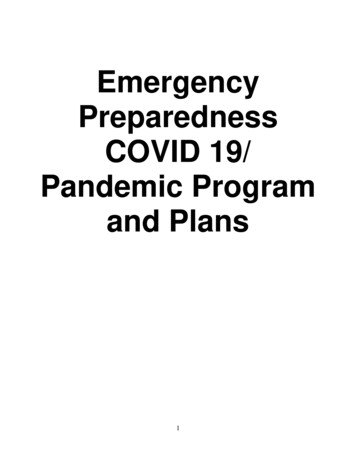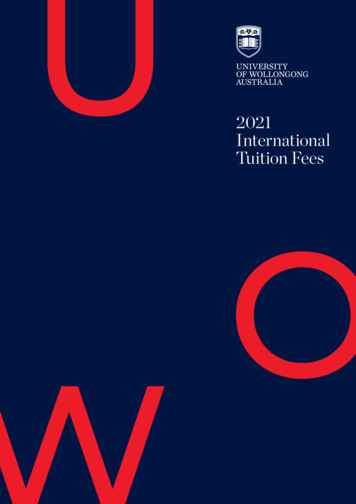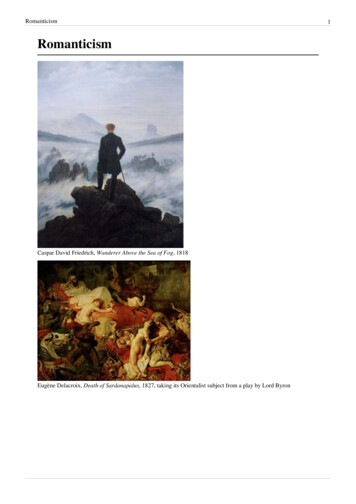
Transcription
ENGL 768—ROMANTICISM IN AND OUT OF PRINT—FALL 2022W 7:00-9:50 PMG06 Colson HallProf. Adam KomisarukEmail: akomisar@wvu.eduCell Phone: (304) 216-7156Office: 217 Colson Hall (by appt. only)Zoom Office Hours: TR 1:00-2:00 by appt.Zoom Address: https://tinyurl.com/adu2ht2fZoom ID: 405 128 5672Zoom Password: revolutionTEXTS (I would prefer that you not substitute different editions) John Keats: A Longman Cultural Edition, ed. Susan Wolfson (Pearson)Mary Shelley, Frankenstein: The Original 1818 Text, Ed. D.L. Macdonald and Kathleen Scherf,3rd ed. (Broadview)Dorothy Wordsworth: A Longman Cultural Edition, ed. Susan Levin (Pearson)Other readings downloadable from eCampusASPECTS OF THE COURSE No later than 3:00 PM on the day of each class session, I would like each of you to post onebrief but substantial comment to our eCampus discussion board about one aspect of the week’sreadings that you find noteworthy. You may either respond to an existing thread or start yourown. These comments will serve as the basis for our class discussion. On the day of your oralpresentation, your posted handout (see below) will constitute your contribution to the board forthe week. I would like each of you to deliver one oral presentation on a primary or secondary textassigned for the week. This need not be a comprehensive introduction, but should address aspecific aspect of the text that you find noteworthy and pose questions to provoke discussion. By12:00 PM on the day of your presentation, please post a 1-page handout to our eCampus boardthat highlights your major points (.PDF format is preferred); it will help guide the subsequentdiscussion there and in class. Your handout will constitute your contribution to the board for thatweek. You will each submit a final project. This may take one of the following forms: a piece of critical scholarship; e.g., a traditional academic essay pertinent to thecourse material and suitable for revision as a journal article (approx. 20 pp.); acritical edition, with full apparatus, of a literary work pertinent to the course (ofsubstantial but manageable length); an anthology, properly introduced andannotated, of texts pertinent to the course (approx. 50 pp.); etc. an original creative work pertinent to the course material, with an introductoryessay (approx. 5-10 pp.) explaining its genesis and rationale a pedagogical project pertinent to the course and suitable for students at a levelof your choosing; most likely, a syllabus with sample lesson plans a public-humanities project pertinent to the course; e.g., a website, a podcast, acommunity-outreach initiative, an installation or exhibit, etc.; with a reflectiveessay (approx. 5-10 pp. if the project is realized, or approx. 20 pp. if onlyproposed)
an external-funding application to pursue a hypothetical project pertinent to thecourse; i.e., a specific grant, scholarship, fellowship, etc. actually available froma specific agency (including all required components except for letters ofrecommendation, and following all steps except for submission)A brief (2-3 pp.) proposal for your project will be due the Friday of Week 7 (9/28); rough draftswill be due the Monday of Week 16 (12/5); we will workshop them in class that Wednesday(12/7); final revisions will be due on the Wednesday of exam week (12/14). All written workmay be uploaded to eCampus.SCHEDULE128/178/24IntroductionModes of readingJerome McGann, from The Textual ConditionFranco Moretti, from Graphs, Maps, TreesStephen Best and Sharon Marcus, “Surface Reading: An Introduction”N. Katherine Hayles, “How We Read: Close, Hyper, Machine”Andrew Elfenbein, from The Gist of ReadingChristina Lupton, from Reading and the Making of Time in the Eighteenth Century3 8/31 Textual technologiesMeet in Rare Book Room with Stewart Plein (West Virginia & Regional History Center,Downtown Library)Erick Kelemen, from Textual Editing and CriticismWilliam Proctor Williams and Craig Abbott, from Bibliographical and Textual Studies4 9/7Textual transmissionMary Shelley, Frankenstein (1818)*Charles E. Robinson, from “Introduction to The Frankenstein Notebooks”William St. Clair, from The Reading Nation in the Romantic Period5 9/14 Pamphlet warsTexts from the French Revolution controversyIan Haywood, from The Revolution in Popular Literature6 9/21 Self-publicationWilliam Blake, The Marriage of Heaven and Hell (transcription online editions)Joseph Viscomi, “Illuminated Printing”Mike Goode, from Romantic Capabilities7 9/28 ManuscriptsDorothy Wordsworth, selected writings* (pp. 5-119, 145-221)Michelle Levy, “Bookmaking and Archiving in Dorothy Wordsworth’s Notebooks”Proposal for final project due Friday 9/30 by 5 PM8 10/5 No Class—Yom Kippur9 10/12 OralityThomas Percy, from Reliques of Ancient English PoetryJoseph Ritson, from Select Collection of English Songs, Northumberland GarlandSir Walter Scott, from Minstrelsy of the Scottish BorderPaula McDowell, from The Invention of the Oral10 10/19 VisualizationImages from the Boydell Shakespeare GalleryFrederick Burwick, from The Boydell Shakespeare GalleryThora Brylowe, from Romantic Art in Practice2
11 10/26 ReviewingJohn Keats, early writings and responses* (pp. 3-78, 137-43, 166-68, 184-99, 203-15)Jeffrey Cox, from Poetry and Politics in the Cockney School12 11/2 IllegitimacyGeorge Gordon, Lord Byron, CainClara Tuite, from Lord Byron and Scandalous Celebrity13 11/9 CanonizationFelicia Hemans, poemsAndrew Piper, from Dreaming in BooksTom Mole, from What the Victorians Made of RomanticismLaura Mandell, “Canons Die Hard”14 11/16 DigitizationPercy Bysshe Shelley, “The Devil’s Walk”Steven Jones, “Digital Romanticism in the Age of Neo-Luddism”Neil Fraistat, “‘Editing Shelley’ Again”Matthew Kirschenbaum and Sarah Werner, “Digital Scholarship and Digital Studies”Robert Darnton, from The Case for Books11/23 Thanksgiving Break—No Class15 11/30 TracesJohn Keats, annotations to Milton* (pp. 224-37)Beth Lau, from Keats’s Paradise LostAndrew Stauffer, from Book TracesBrowse booktraces.orgSpecial guest: Prof. Andrew Stauffer, U of Virginia (via Zoom)Rough draft of final project due Monday 12/5 by 5 PM16 12/7 Peer-review workshopRevision of final project due Wednesday 12/14 by 5 PMSELECTIVE ANNOTATED BIBLIOGRAPHY* print copy available in WVU Libraries*e electronic copy available through WVU LibrariesJennie Batchelor and Manushag Powell, eds., Women’s Periodicals and Print Culture in Britain, 1690s1820s: The Long Eighteenth Century (Edinburgh, 2018) *eFirst volume in a five-volume series going up to the 2000s. Thirty essays on publications with womenfounders (Eliza Haywood’s Female Spectator), women audiences (Lady’s Magazine), and/or womencontributors (Gentleman’s Magazine).Stephen Behrendt, ed., Romanticism, Radicalism and the Press (Wayne State, 1997)Early essays on Cobbett, Percy Shelley, Thelwall, Wordsworth, et al. by soon-to-be-major scholars.Jeffrey Cox, Poetry and Politics in the Cockney School: Keats, Shelley, Hunt and Their Circle(Cambridge, 1998) *One of the first major challenges to the “solitary genius” myth, shows the intensely social nature ofauthorship among the second-generation Romantics, especially in the wake of conservative press attacks.Ina Ferris, ed., Romantic Libraries (Romantic Circles Praxis, 2004) *e3
Three essays: on bibliophilia, Thomas Frognall Dibdin’s Bibliomania (1809), and private libraries in Prideand Prejudice. For more of an overview, see instead St. Clair.Andrew Franta, Romanticism and the Rise of the Mass Public (Cambridge, 2007) *eWith a focus on poetry, belongs to a cluster of arguments (Klancher, Gamer, Cox) tying Romanticconceptions authorship intimately to the Romantic construction of audience. “Publicity” as a “mode ofaction”, something not born but made. Includes case-studies of Keats, Shelley, Wordsworth.---, Systems Failure: The Uses of Disorder in English Literature (Johns Hopkins, 2019) *eHow attempts to map, emplot, and otherwise systematize society through narrative inevitably break down.Readings of Sterne, Samuel Johnson, Smollett, Godwin, Austen, DeQuincey.Michael Gamer, Romanticism and the Gothic: Genre, Reception and Canon Formation (Cambridge,2000) *eInnovative if idiosyncratic study that avoids the usual suspects (Horace Walpole, Ann Radcliffe, MaryShelley) for those that thematize literary reception (Coleridge, Wordsworth, Joanna Baillie) and so“domesticate” a genre regarded as excessively German.---, Romanticism, Self-Canonization, and the Business of Poetry (Cambridge, 2017)How poets like Wordsworth, Southey, and Charlotte Smith saw to their own collection/anthologizationduring their lifetimes and, thus, helped secure their own reputations as professionals.Kevin Gilmartin, Print Politics: The Press and Radical Opposition in Early Nineteenth-Century England(Cambridge, 1996)From our most level-headed chronicler of the Romantic right wing, especially prose writers; shows howrevolutionary and counter-revolutionary efforts played out in popular periodicals and other mass media.---, Writing against Revolution: Literary Conservatism in Britain, 1790-1832 (Cambridge, 2007) *eBuilds on his earlier Print Politics to focus on writers such as Burke, Coleridge, More, Southey; as well asreview periodicals such as the Anti-Jacobin, Blackwood’s, and the Quarterly.Mike Goode, Romantic Capabilities: Blake, Scott, Austen, and the New Messages of Old Media (Oxford,2021) *eHow Romantic authors thematize mediation and so anticipate the afterlives of their texts. Remediation ofBlake’s proverbs in popular culture, Scott’s novels in Victorian photography, Austen in fan fiction.Katherine Harris, Forget Me Not: The Rise of the British Literary Annual, 1823-1835 (Ohio, 2015) *eThe gift-book miscellany in the late Romantic period, especially the role of the bookseller-publisherRudolph Ackermann and of women authors. Appendices include tables of titles, contributors, and editorsand publishers; and transcriptions of selected poems from the annuals.Ian Haywood, The Revolution in Popular Literature: Print, Politics, and the People, 1790-1860(Cambridge, 2004)4
Like others of its ilk (Klancher, McCalman, Gilmartin, Keen, Mee et al.), discusses how the Revolutioncontroversy was constructed in mass media; but ventures farther into the Chartist debate of the Victorianperiod, and with greater attention to women writers like Hannah More and Maria Edgeworth.Jillian Hess, How Romantics and Victorians Organized Information: Commonplace Books, Scrapbooks,and Albums (Oxford, 2022)Commonplacing as not just a vestige of antiquity, but a practice that “evolved to fit new epistemic virtuesand technological capabilities”, from Coleridge to the nineteenth-century laboratory scientists to QueenVictoria.Yohei Igarashi, The Connected Condition: Romanticism and the Dream of Communication (Stanford,2019) *eThe (im)possibility of (im)mediate understanding between authors and readers. Brings communicationstheory to bear on Romantic textual technologies: Coleridge as stenographer, Wordsworth as bureaucrat, etc.H.J. Jackson, Romantic Readers: The Evidence of Marginalia (Yale, 2005) *eWhat handwritten annotations in the margins of about two thousand Romantic books tell us about readingpractices in the period. Also a useful overview of contemporary print-culture, more portable than St. Clair.Paul Keen, The Crisis of Literature in the 1790s: Print Culture and the Public Sphere (Cambridge, 1999)*eShows how hegemonic ideas of a bourgeois “republic of letters” were both advanced and contested by“subaltern counterpublics” in the early British response to the French Revolution.Theresa Kelley and Diedre Lynch, eds., “The Matter of the Archive”, special issue of Studies inRomanticism 57.1 (Spring 2018) *eSix essays on artifacts: clothing exhibits, “billets” that accompanied foundling infants, rag paper,scrapbooks, antiquarian collections, color theory.Rachael Scarborough King, ed., After Print: Eighteenth-Century Manuscript Cultures (Virginia, 2020) *eTwelve essays about how the printed codex coexisted with other media in the eighteenth century—manuscripts, letters, journals, etc.—how one could be remediated to the other, and what “originality”means in this environment. The implications for digital culture and textual scholarship today.Jon Klancher, The Making of English Reading Audiences, 1790-1832 (Wisconsin, 1987)Short and massively influential study demonstrating the importance of Romantic print-culture, especiallyperiodicals (pre-digitization!), in not only fulfilling but shaping expectations of a literate public.Maurice Lee, Overwhelmed: Literature, Aesthetics, and the Nineteenth-Century Information Revolution(Princeton, 2019) *eConversational but rigorous study of “textual excess” in the transatlantic nineteenth century, and digital-agescholarship thereon. Readings of Coleridge, Emerson, Hawthorne, Dickens.Michelle Levy, Literary Manuscript Culture in Romantic Britain (Edinburgh, 2021) *e5
The “importance of scribal practices”, especially for women writers (Austen, Barbauld, Charlotte Smith,Dorothy Wordsworth); discussions also of Blake, Byron. Manuscripts not necessarily destined to wind upin print, nor necessarily for private consumption only.--- and Andrew Stauffer, eds., “Romantic Women and Their Books”, special issue of Studies inRomanticism 60.4 (Winter 2021) *eNine essays that seek to recuperate the material dimensions of women’s writing in the “Romantic century”(1750-1850), and so continue the gradual reversal of what Clifford Siskin called the “Great Forgetting” ofthis writing.Alan Liu, Friending the Past: The Sense of History in the Digital Age (Chicago, 2018)Temporality in old media and new, by one of the first critics to take seriously the historicist, and digital,possibilities of Romanticism.Christina Lupton, Reading and the Making of Time in the Eighteenth Century (Johns Hopkins, 2018) *eHow the problem of finding time to read, then and now, relates to broader systems of temporality andfuturity.Samantha Matthews, Album Verses and Romantic Literary Culture: Poetry, Manuscript, Print, 17801850 (Oxford, 2020) *eThe culture of the Romantic album—blank scrapbooks which the owner filled with autograph poems bycontemporaries, some amateur and some well-known (Crabbe, Southey, Lamb, Byron). The centrality ofgender in “albo-mania” and “albo-phobia.”Iain McCalman, Radical Underworld: Prophets, Revolutionaries, and Pornographers in London, 17951840 (Cambridge, 1988)Minutely detailed, archivally based history showing how different strands of ultra-contrarianism convergedonce Britain became officially opposed to the French Revolution.Paula McDowell, The Invention of the Oral: Print Commerce and Fugitive Voices in Eighteenth-CenturyBritain (Chicago, 2017)Convincingly argues that the celebrated “authenticity” of “oral tradition” was itself a construction specificto the age of print.Maureen McLane, Balladeering, Minstrelsy, and the Making of British Romantic Poetry (Cambridge,2008)Building on work by Trumpener, sees the minstrel (vs. the bard) as a figure of belatedness. Despite thedream of what Walter Ong called a “primary orality”, Romantic poetry was inescapably “fallen” into print.Discussions of ballads from MacPherson (“Ossian”), Percy, Ritson, Blake, Wordsworth, Scott, moderns.Jon Mee, Print, Publicity and Popular Radicalism in the 1790s (Cambridge, 2016) *eEnglish radicalism as a phenomenon that could not have flourished without print. One of the more detailedstudies of the London Corresponding Society and the Society for Constitutional Information. Includesfigures both canonical (Paine, Spence, Thelwall) and not (Richard Lee, Robert Merry, Charles Pigott).6
Tom Mole, What the Victorians Made of Romanticism (Princeton, 2018) *eThe Romantic legacy as something retroactively constructed in nineteenth-century material objects likeanthologies, illustrated editions, and monuments. One of several studies to stress the afterlives of Romantictexts, as against the “punctual historicism” that considers only their original context.Multigraph Collective, Interacting with Print: Reading in the Era of Print Saturation (Chicago, 2019)Neither a monograph nor a collection but an experiment in joint authorship by twenty-two scholars. Short,alphabetically ordered, theoretically informed chapters introduce material aspects of Romantic-age bookculture: “Advertising”, “Binding”, “Ephemerality”, “Paper”, etc.Clare Pettitt, Serial Forms: The Unfinished Project of Modernity, 1815-1848 (Oxford, 2020) *e“Seriality is the defining form of modernity” in that it institutes a “new regime of time.” First in a proposedthree-volume study, focuses on social reconfigurations between the Napoleonic wars and the revolutions of1848. Periodicals, serial poetry of Byron, serial novels of Dickens.Andrew Piper, Dreaming in Books: The Making of the Bibliographic Imagination in the Romantic Age(Chicago, 2009)One of the first major studies to situate Romanticism within the material history of the book. Subtopicsinclude the idea of the critical edition, the “collected works”, the gift-book miscellany, the translation, theline-illustrated book. Draws heavily on German traditions alongside British.Dahlia Porter, Science, Form, and the Problem of Induction in British Romanticism (Cambridge, 2018)How polymaths like Coleridge, Southey, and Erasmus Darwin struggled to achieve intellectual synthesis inan age of information overload. Ambitious attempt to marry the history of science to the history of thebook.Betty Schellenberg and Michelle Levy, eds., “Women in Book History, 1660-1830”, special issue ofHuntington Library Quarterly 84.1 (Spring 2021) *eTwenty-three short essays and responses examining the role of women at all stages of production in thelong-eighteenth-century book trade—not just authorship but editing, selling, collecting, etc.William St. Clair, The Reading Nation in the Romantic Period (Cambridge, 2004) *Indispensable: challenges myths about the Romantic canon by trying to reconstruct what people in theperiod were actually reading. Dozens of charts detailing print runs, pricing, sales figures, etc.Andrew Stauffer, Book Traces: Nineteenth-Century Readers and the Future of the Library (Penn, 2021)*eThe things readers in and of the Romantic period left behind in their books—marginal annotations, pressedflowers, etc.—and how they help make the case for the library in the digital age. Companion website hasthousands of user-submitted images, all from pre-1923 books in circulating collections.Katie Trumpener, Bardic Nationalism: The Romantic Novel and the British Empire (Princeton, 1997) *e7
Evolving interest in the figure of the Celtic bard, from the Ossian controversy to the tales of Walter Scott,as it relates to the consolidation of British nationhood locally (Wales, Scotland, Ireland) and abroad(Canada, the East and West Indies).Orrin Wang, Techno-Magism: Media, Mediation, and the Cut of Romanticism (Fordham, 2022)Eight somewhat recondite essays on media theory in and about Romantic texts. The ambivalentrelationship between technology and transcendent knowledge.Abigail Williams, The Social Life of Books: Reading together in the Eighteenth-Century Home (Yale,2017) *eThe many social dimensions of shared reading: as hospitality, pedagogy, status marker, privatetheatricality, religious devotion. Considers the practical aspects of domestic spaces (architecture, lighting)and their relation to non-domestic (libraries, bookshops, clubs). Wide-ranging rather than author-based.Marcus Wood, Radical Satire and Print Culture, 1790-1822 (Oxford, 1994)Historically scrupulous account of verbal and visual works from the Parliamentary-reform movement of theearly nineteenth century, especially William Hone and his legal travails.8
Andrew Piper, Dreaming in Books: The Making of the Bibliographic Imagination in the Romantic Age (Chicago, 2009) One of the first major studies to situate Romanticism within the material history of the book. Subtopics include the idea of the critical edition, the "collected works", the gift-book miscellany, the translation, the
